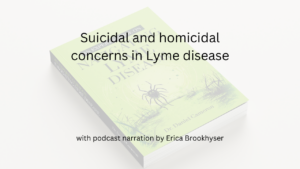Call for your appointment today 914-666-4665 | Mt. Kisco, New York

Welcome to an Inside Lyme case study. I find that the best way to get to know Lyme disease is through reviewing actual cases. I will discuss four Lyme disease patients that developed Post Treatment Lyme disease syndrome (PTLDS).
Wormser and colleagues first described these four cases in the journal Diagnostic Microbiology and Infectious Disease in 2019.
Wormser and colleagues cited one of his papers and a paper by Stupica to justify ten days of doxycycline for the treatment of early Lyme disease. Wormser and colleagues write, “Convincing data indicate that a 10-day course of oral doxycycline is equally as effective as 15-day or 20-day treatment courses with this antibiotic”.
I am one of many doctors who are not convinced. There are too many treatment failures whether the doctor prescribes a 10-day, 15-day, or 20-day course of doxycycline.
[bctt tweet=”There is no reliable test to prove a persistent infection has cleared. There is growing evidence that Lyme disease or co-infections can persist in some patients.” username=”DrDanielCameron”]
Wormser and colleagues set out to prove that 14 days of amoxicillin would be safe and effective.
Twenty-four adult patients with an Erythema Migrans (EM) rash were included in the study. A third of their patients had multiple EM rashes. All patients had a positive test for Lyme disease by culture or a C6 Lyme enzyme immunoassay.
All 24 patients were prescribed a 14-day course of amoxicillin. Two patients were treated with additional antibiotics.
The EM rash cleared in all 24 subjects. That is not a surprise as the EM rash typically clears without antibiotic treatment.
None of their 24 patients were left with objective findings after a year. They appeared to focus on objective findings like Bell’s palsy, Lyme arthritis, heart block, or meningitis.
At least four of their 24 patients remain ill on follow-up. They were diagnosed with Post Treatment Lyme Disease Syndrome (PTLDS).
Wormser and colleagues defined PTLDS as “subjective symptoms attributed to Lyme disease that had persisted continuously or intermittently for at least six months following completion of antibiotic treatment with amoxicillin.”
Wormser and colleagues did not describe the symptoms or loss of function of patients diagnosed with PTLDS. Researchers at Johns Hopkins described six patients with PTLDS.
Their patients with PTLDS suffered not only from severe fatigue, impaired cognitive function, and pain but also suffered from poor function.
Wormser and colleagues did not report symptoms important to Lyme disease patients. The list includes fatigue, poor sleep, impaired concentration, headaches, lightheadedness, neck and joint pain, muscle pain, and paresthesias. Paresthesias refer to numbness and tingling or a“pins-and-needles” sensation.
Nor did Wormser and colleagues describe other complications of Lyme disease important to patients. This list includes Lyme encephalopathy, Lyme neuropathy, Postural tachycardia syndrome (POTS), Pediatric Acute-onset Neuropsychiatric Syndrome (PANS), and Neuropsychiatric Lyme disease.
Treatment of PTLDS
Wormser and colleagues did not suggest additional antibiotic treatment for these four patients with PTLDS. PTLDS was considered a syndrome rather than a persistent infection.
Yet, there is no reliable test to prove a persistent infection has cleared.
There is growing evidence that Lyme disease or co-infections can persist in some patients. This evidence was not addressed in this paper.
Some doctors remain reluctant to consider additional antibiotic treatment for a patient with PTLDS.
These 4 patients with PTLDS were not offered additional treatment.
What can we learn from these PTLDS cases?
- A 14-day course of amoxicillin was effective at clearing a rash and preventing objective findings in 24 patients.
- A 14-day course of amoxicillin was not effective at preventing PTLDS, a poor outcome important to Lyme disease patients.
- It is not clear from the study whether a 14-day course of amoxicillin would be effective at preventing symptoms or other complications of Lyme disease.
What questions does these cases raise?
- How effective is a 10-day, 14-day, or 20-day course of doxycycline for early Lyme disease effective at preventing symptoms and complications of Lyme disease?
- What is the best treatment to prevent PTLDS and other complications of Lyme disease?
Treating Tick-Borne Disease
We need more research on the best treatment regimens to prevent PTLDS and other complications of Lyme disease. We need doctors with experience diagnosing and treating PTLDS and other complications. We should not dismiss patients diagnosed as PTLDS as suffering from a syndrome until we have a reliable test to rule out a persistent tick-borne infection.
We need to give doctors the freedom to treat these difficult cases without undue interference by colleagues, insurance companies, medical societies, and medical boards.
Inside Lyme Podcast Series
This Inside Lyme case series will be discussed on my Facebook and made available on podcast and YouTube. As always, it is your likes, comments, and shares that help spread the word about this series and our work. If you can, please leave a review on iTunes or wherever else you get your podcasts.
Sign up for our newsletter to keep up with our cases.
References:
- G.P. Wormser, K.C. Brady,M.S. Cho, et al. (2019). Efficacy of a 14-day course of amoxicillin for patients with erythema migrans, Diagnostic Microbiology and Infectious Disease.
- Wells, R., et al. (2018). “Postural tachycardia syndrome: current perspectives.” Vasc Health Risk Manag 14: 1-11.




Would a multiple lesion rash, as indicated in this case study for a third of the patients, be indicative of a higher concentration of exposure to infection ( more than one infected tick bite especially if engorged or a previously misdiagnosed infection) possibly crossing the blood brain barrier contributing to severity of illness or ineffectiveness of antibiotic treatment?
Disseminated Lyme disease is typically early in the illness. We do not know enough to answer these questions.